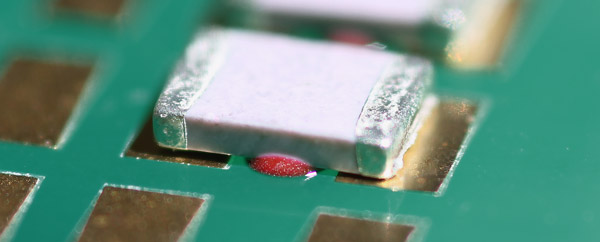
![]() Glue process in electronic manufacturing
Glue process in electronic manufacturing
Conductive and non-conductive joining processes are seeing rapid growth in electronic manufacturing thanks to improvements in the formulation of fluids, pumps and modern dispensing equipment. These technologies open up a wealth of applications such as MEMS packaging, exact LED positioning, heavy component placement or power modules to name just a few. Moreover, these technologies also remove some of the design constraints inherent with double sided reflow soldering. The application of SMT glues for double sided boards goes back many years and was considered a challenging and unreliable process. Typically, it involved either contact dispensing with a needle and stand-off, or screen printing the glue with a stencil. The former had heavy restrictions on design, dot size and speed, while the latter caused smearing and yield loss if the stencil was not kept absolutely clean. The industry has overcome these restrictions with modern jet dispensing technology and specially formulated fluids which offer fast, reliable and cost efficient processes.
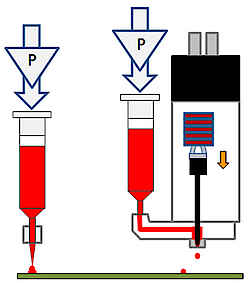
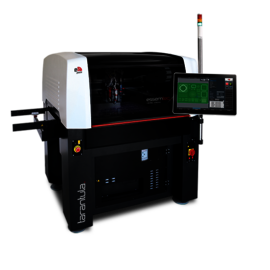
Figure 1 Comparison of time pressure vs jet pump
As everyone knows, production managers have to be highly skilled to adapt their work orders to shifts in demand, equipment availability and manpower. A process that is highly productive, easily controlled and stable, but offers on-the-fly adjustments for prototypes and NPI boards is most welcome. In the following paragraphs we highlight some of the more important output parameters of today’s glue processes. One of the glue processes was implemented at the largest European electronic contract manufacturing company and more than a dozen manufacturing lines have been commissioned, giving prove to their robustness in 24/7 production.

Figure 2 Glue and Solder Paste dots on PCB
Traditional needle dispensing has numerous disadvantages with respect to speed, single dot size, process stability (tailing, repeatability, clogging) and lastly the need to contact the board. In contrast, jet dispensing overcomes these limitations by a large margin. The jet head can dispense from up to ¼ inch from the target surface and therefore be used on populated boards and cavities. Jet dispensing of glue dots has qualitative advantages over stencil printing and offers much higher flexibility as the number of dots and their size can be adjusted on the fly.
Depending on the size of a board and its design, jet dispensing can achieve higher throughputs than stencil printing.
Media | Positioning Accuracy [µm] | Jetting Speed [cph] | |
| 3621 | 25 @3s | 58000 |
| PD205.JET | 30 @3s | 54200 |
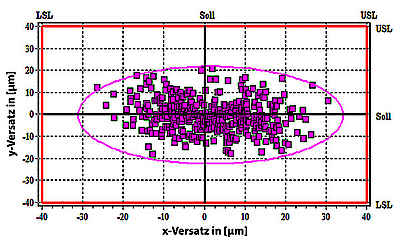
Figure 3 XY-Positioning Accuracy at Full Speed
Hence we propose to adapt the test procedure as per the IPC 9850A while jetting 0.5mm dots.

Figure 4 Volumetric precision and drift over time
A specialized measurement equipment (CTQ) was used to measure the relative deviation from the etched coordinate grid on the glass plate using an optical, differential measurement mode. The same equipment is used to measure placement accuracy for pick & place machines. Speed tests were carried out using the IPC 9850A test board.
In this experiment, 416 dots of nominally 300 µm each were dispensed and measured. Then the machine was paused and the series repeated after 1 hour and again after 4 hours. As can be observed, there is no measurable process drift:
Media | Smallest Dot Diameter | Deviation | Largest Dot Diameter [µm] | Deviation | |
| 3621 | 300 ±13@3s | 4.9 | 1800 ±48@3s | 3.0 |
| PD205.JET | 330 ±20@3s | 5.7 | 2000 ±67@3s | 2.5 |
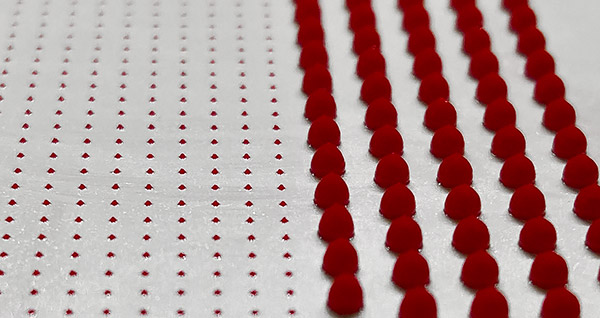
Figure 5 Dot geometry, shape and size
In this experiment, 416 dots of nominally 300 µm each were dispensed and measured. Then the machine was paused and the series repeated after 1 hour and again after 4 hours. As can be observed, there is no measurable process drift. The error margin of all measured points (3 x 416) is less than 5%. Each 300 µm dot weighs about 0.010 mg, as measured by a Mettler microbalance which is also part of the equipment. The results for both glues are similar. Thus we conclude that both glues can be jetted with excellent repeatability, stability and accuracy.
But how is it possible to achieve such a wide range of dot sizes using just one hardware setup? Essemtec’s piezo driver is voltage controlled in such a manner that the quality, geometry and energy of each dots can be precisely adjusted while the machine dispenses. Using ePlace software, the dot shape and size can be programmed for each board location if so desired. As can be seen in Figure 5, the aspect ratio (height to diameter) can also be adjusted by changing the dot energy. The energy of each dot can be programmed by changing the slew rate of the piezo voltage, while the open time determines the volume. This degree of freedom is equally important to be able to jet a wide range of materials with varying viscosities. Other factors to observe are the rheological properties of the fluid.
Flexibility and stability of your glue process


![[Translate to Englisch:] kleber-dosieren-bauteil-auf-lotpaste](/fileadmin/_processed_/1/5/csm_kleber-dosieren-bauteil-auf-lotpaste_3a0c1799e5.jpg)
